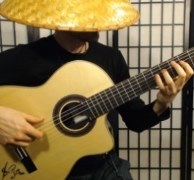Welcome to one of the most active flamenco sites on the Internet. Guests can read most posts but if you want to participate click here to register.
This site is dedicated to the memory of Paco de Lucía, Ron Mitchell, Guy Williams, Linda Elvira, Philip John Lee, Craig Eros, Ben Woods, David Serva and Tom Blackshear who went ahead of us.
We receive 12,200 visitors a month from 200 countries and 1.7 million page impressions a year. To advertise on this site please contact us.
|

|
|
Fandangos structure and accompaniment
|
You are logged in as Guest
|
|
Users viewing this topic: none
|
|
Login  | |
|

   
Ricardo
Posts: 14841
Joined: Dec. 14 2004
From: Washington DC

|
 RE: Fandangos structure and accompan... (in reply to Munin) RE: Fandangos structure and accompan... (in reply to Munin)
|
|
|
For dance it is always fandango de huelva. There are two main types of melodies used for dance, with a final remate they call "por bulerias" but it never felt like buleria to me.
After you figure out how you will structure any falseta or estribillo (chorus that might repeat or go between coplas) and number of basic compases (4 measures usually is one compas) then you have these types of coplas (using the basic compasing for chord you say you know well already)
G7-C (depending on the melody, the C chord change comes right on the 3rd beat of the first measure, or on the 3rd beat of the 3rd measure)
So either beats 1-6, or you have just G7 for beats 1-6, then G7-C for the next 7-12 beats.
The rest is always the same.
C-C (1-6) C7-F (7-12)
F-G7 (1-6) G7-C (7-12)
C-C, C(orD7 passing)-G7
G7-G7, G7-C
C7-F, F-E
So you see the copla is always 6 compases long (or 5 1/2 if you do that short version in the beginning...depends on the melody and it is obvious). If you opt to play copla type falseta (such as the ones PDL does in his guitar solos), be aware they often have an extra 2 compas tag to square things off, so you need to cut those so it is clear 6 compases. And only do the 1/2 compas thing if there is a singer.
The other type of melody is the exact same length, but you go to A major instead of C major:
E7-E7, E7-Amajor
Am (minor)-Am, Am-E7
E7-E7, E7-A (major)
Am-Am, Am-E7
E7-E7, E7-A
Am-F, F-E
Those are the main type of coplas they use for dance, you have to work out how many they want in advance, and what to do between them. The final verse tends to speed up with the lyrics "Arimate ay, gitana mia....etc". The chords are:
E7-Am, G-F-E, repeat, then
Am (I like C major here)-Am, G-G, F-F, G-F-E....
The final is
Am-G, G-F, F-E....repeat, and then sometimes an extra little tag F-E...depends on the dancer, I can usually tell by their motion if they will do that or not.
Hope that helps.
_____________________________
CD's and transcriptions available here:
www.ricardomarlow.com
|
|
|
|
REPORT THIS POST AS INAPPROPRIATE |
Date Sep. 17 2011 20:12:19
 |
|
 New Messages New Messages |
 No New Messages No New Messages |
 Hot Topic w/ New Messages Hot Topic w/ New Messages |
 Hot Topic w/o New Messages Hot Topic w/o New Messages |
 Locked w/ New Messages Locked w/ New Messages |
 Locked w/o New Messages Locked w/o New Messages |
|
 Post New Thread
Post New Thread
 Reply to Message
Reply to Message
 Post New Poll
Post New Poll
 Submit Vote
Submit Vote
 Delete My Own Post
Delete My Own Post
 Delete My Own Thread
Delete My Own Thread
 Rate Posts
Rate Posts
|
|
|
Forum Software powered by ASP Playground Advanced Edition 2.0.5
Copyright © 2000 - 2003 ASPPlayground.NET |
0.046875 secs.
|


 Printable Version
Printable Version






 New Messages
New Messages No New Messages
No New Messages Hot Topic w/ New Messages
Hot Topic w/ New Messages Hot Topic w/o New Messages
Hot Topic w/o New Messages Locked w/ New Messages
Locked w/ New Messages Locked w/o New Messages
Locked w/o New Messages Post New Thread
Post New Thread